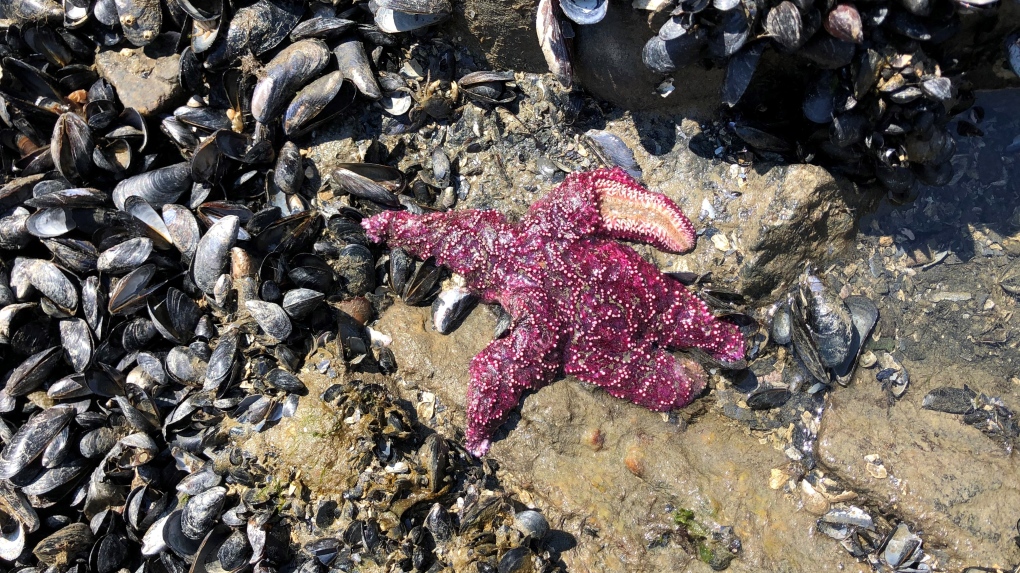'It's very disturbing': Expert says sea stars melting away because of wasting disease
 Researchers believe more than one billion intertidal animals may have died during B.C.'s record-breaking heat wave: (Chris Harley)
Researchers believe more than one billion intertidal animals may have died during B.C.'s record-breaking heat wave: (Chris Harley)
Sea stars in the waters off British Columbia that died off in the billions about a decade ago are not recovering as expected, an expert says.
A new study published by the Royal Society said sea stars are getting close to extinction as waters along the west coast, including in California and Mexico, warm faster because of climate change.
There are still some populations of sea stars in B.C. waters, but it's unclear if they'll survive, said Sara Hamilton, who is a PhD student at Oregon State University and lead author of the study.
These “charismatic creatures” have been wasting away since 2013, she said, and studies have shown this could be due to bacteria or a virus that thrives in warm waters.
“Mexico and Southern California sea stars were wiped out in a matter of a couple of months,” she said in an interview Tuesday.
“Whereas Alaska and British Columbia where it's much cooler, you know we still have remnant populations. So, there's evidence for sure that temperature is somehow related to it.”
Sea stars, also known as starfish, come in multiple bright colours, including purple, yellow and red. While many have five arms and are shaped like a star, other starfish species have 10, 20 and even 40 arms and can grow to a metre in diameter.
Alyssa Gehman, a co-author of the study, said she is worried about the large decline of the sea star population in B.C. waters.
Gehman is a scientist with the Hakai Institute, which conducts long-term scientific research in remote locations on B.C.'s coast.
“As everyone has experienced, the temperatures are increasing here as well, and so I'm really concerned that that's going to put the species at risk,” she said in an interview.
Hamilton said the sea stars have been ever-present and people are used to seeing them on the beach or while diving.
“Then all of a sudden they were gone. It's been an ecosystem loss, a cultural loss. A loss of childhood memories.”
Hamilton said the wasting disease that attacks them leaves white or discoloured lesions on their surface and can destroy adult and juvenile sea stars within 48 hours.
“Those lesions start to spread over their body, and I mean it would be like if we lost all of our skin,” Hamilton said.
“Their insides start pouring out. Some of their arms begin to fall off because the lesions disconnect their arms. It's very disturbing.”
The massive loss of sea stars has also upset the ecological balance in coastal oceans, as the starfish once kept sea urchins in check, which now feast on kelp forests.
Kelp is an important habitat for other marine wildlife to use for food and shelter, she said.
“As you lose sea stars, their role in the ecosystem dims and they shine a little less bright.”
Gehman said one of the solutions is raising the animals in a lab while working on finding out what is causing the disease.
“I mean stop climate change,” she said. “That is actually one of the things that we sort of come back to. But that really is the thing that needs to happen to save these animals.”
This report by The Canadian Press was first published Aug. 25, 2021.
CTVNews.ca Top Stories

BREAKING Police to announce arrests in $20-million Toronto Pearson airport gold heist
Police say that arrests have been made in connection with a $20 million gold heist at Toronto Pearson International Airport one year ago.
Outdated cancer screening guidelines jeopardizing early detection, doctors say
A group of doctors say Canadian cancer screening guidelines set by a national task force are out-of-date and putting people at risk because their cancers aren't detected early enough.
Lululemon unveils first summer kit for Canada's Olympic and Paralympic teams
Lululemon says it is combining function and fashion in its first-ever summer kit for Canada's Olympians and Paralympians.
Canada's health-care crisis was 'decades in the making,' says CMA
The strain placed on Canadian health care during the COVID-19 pandemic shows no sign of abating, and the top official of the Canadian Medical Association (CMA) is warning that improving the system will be a 'slow process' requiring sustained investment.
'I just started crying': Blue Jays player signs jersey for man in hospital
An Ontario woman says she never expected to be gifted a Blue Jays jersey for her ailing husband when she sat alone at the team’s home opener next to a couple of kind strangers.
Mussolini's wartime bunker opens to the public in Rome
After its last closure in 2021, it has now reopened for guided tours of the air raid shelter and the bunker. The complex now includes a multimedia exhibition about Rome during World War II, air raid systems for civilians, and the series of 51 Allied bombings that pummeled the city between July 1943 and May 1944.
LIVE @ 4 EDT Freeland to present 2024 federal budget, promising billions in new spending
Canadians will learn Tuesday the entirety of the federal Liberal government's new spending plans, and how they intend to pay for them, when Deputy Prime Minister and Finance Minister Chrystia Freeland tables the 2024 federal budget.
B.C. woman facing steep medical bills, uncertain future after Thailand crash
The family of a Victoria, B.C., woman who was seriously injured in an accident in Thailand is pleading for help as medical bills pile up.
Step inside 'The Brain': Northern education tool aims to promote drug safety
An immersive experience inside a massive dome coined 'The Brain' is helping youth learn about brain function and addiction
































